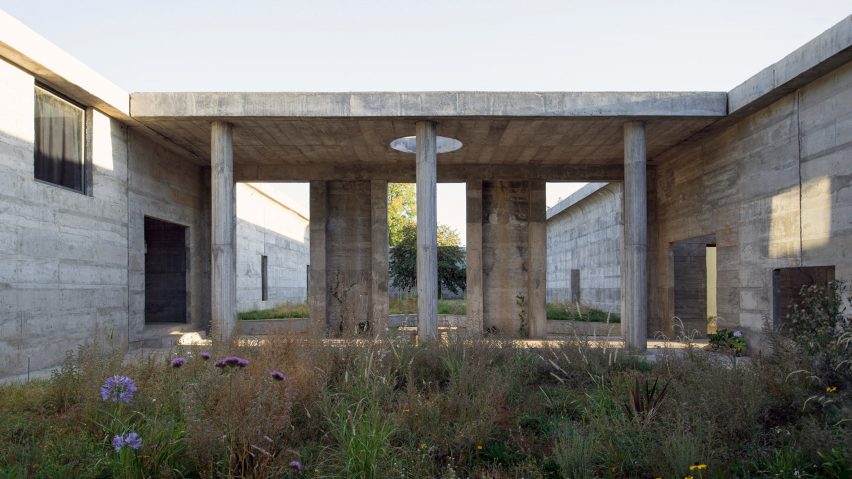Chilean architects Mauricio Pezo and Sofia von Ellrichshausen have built a series of concrete buildings that come together to form a fortress-like compound.
Located at the base of the Andes mountains in Chile, Luna House looks like one huge cast-concrete structure. In fact, it consists of 12 small buildings organised in a grid around four expansive courtyards.
The architects, who lead the studio Pezo von Ellrichshausen, describe the 2,400-square-metre structure as "a large and a small building".
"The interior space is no more than a fifth of the total footprint," Von Ellrichshausen told Dezeen.
Luna House is the third self-commissioned structure that Pezo and Von Ellrichshausen have constructed. It is located on a 130-hectare site they own in Yungay, beside the Cholguan River.
The complex can be used in different ways – as accommodation, a workplace or as an exhibition space.
All 12 blocks have their own shapes and proportions. Each one also integrates different design features, from unusual window openings to playful wall arrangments.
The rooms interact in different ways with the four courtyard spaces, which are also differently sized and have their own unique characteristics.
The largest courtyard contains a pond and some old trees, while the smallest houses a circular flower garden. The other two are long and thin, with one that follows the slope of the terrain and another that is totally flat.
"It is meant to be a speculation, perhaps with the ambition of a built essay, about the reciprocity between architecture and nature, and about the form of life and its formalisation," said Pezo.
The starting point for the design was the idea of creating a cloister that frames a large area of natural landscape.
As with a cloister, it is possible to move through the various buildings of Luna House in sequence.
The junctions between buildings take the form of "visible seismic joints", so you clearly see where one block ends and another begins.
The complex has a consistent roof level, even though the landscape naturally slopes down.
To achieve this, buildings at the western end are two-storey, while the others are single-storey.
The majority of the structure is formed of reinforced concrete, which is highly textured thanks to imprints left behind by wooden formwork.
In some places, this creates patterns that exaggerate the geometries.
"Luna is not only a space for the production of art and architecture, but also for the cultivation of gardens, orchards and landscape," said Von Ellrichshausen.
"Despite its rough material opacity, it becomes a neutral backdrop for life to unfold," she stated. "Not only human life but the very complexity of the native ecosystem."
Pezo von Ellrichshausen's previous projects on this site are Poli, a highly geometric house used for artist residencies, and Cien, the architects' own home and studio.
Luna House repeats some compositions from these projects, such as repeating sequences of doorways, or circular rooms located within rectilinear volumes.
New juxtapositions can also be found. One room has a firepit in its centre, while another features a grid of small circular skylights.
In the long term, the architects plan to turn the entire site into a destination where culture and nature intersect.
"Luna somehow completes a triangular project, both romantic and intimate, that we initiated 20 years ago with Poli and then continued with Cien," added Von Ellrichshausen.
"We are developing a cultural institution, named Artificial Foundation, to allow the three places to be open to the public, and to leave the native forest as a protected natural reserve."
The photography is by Pezo von Ellrichshausen.
Project credits:
Client: Fundacion Artificial
Architect: Pezo von Ellrichshausen (Mauricio Pezo and Sofia von Ellrichshausen)
Collaborators: Emilie Kjaer, Maria Arnold, Isabella Hubsch, Thomas Harlander, Fabian Puller, Olga Herrenbrücks, Torun Stjern, Simon Bohnet, Amelie Bès, Elina Zempetakis, Jeffrey Wu, Jasper Lorenz, Hannah Frossard, Pablo Valsangiacomo
Structure: Sergio Contreras
Construction: Constructora Natural

